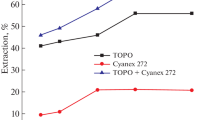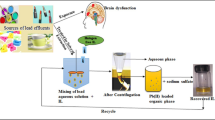Abstract
Ruthenium, rhodium and platinum are the most expensive of noble metals. As their natural sources are limited, it is important to develop an effective process for recovering Rh, Ru and Pt from waste sources. Their main suppliers are the following industries: chemical (spent catalysts), automotive, jewellery, dental and petrochemical. This paper presents studies on the extraction of Rh(III), Ru(III) and Pt(IV) from model aqueous chloride solutions using trihexyl(tetradecyl)phosphonium bromide (Cyphos IL 102). The effects of different parameters such as the influence of shaking time, HCl and NaCl concentrations in the feed solutions and also Cyphos IL 102 concentration in the organic phase, on the extraction of these metal ions were investigated. Additionally, the effect of the ageing of Rh(III) and Ru(III) chloride solutions on the extraction of these metal ions was studied.
Similar content being viewed by others
References
Aktas, S. (2011). Rhodium recovery from rhodium-containing waste rinsing water via cementation using zinc powder. Hydrometallurgy, 106, 71–75. DOI: 10.1016/j.hydromet.2010. 12.005.
Angelidis, T. N. (2001). Development of a laboratory scale hydrometallurgical procedure for the recovery of Pt and Rh from spent automotive catalysts. Topics in Catalysis, 16/17, 419–423. DOI: 10.1023/a:1016641906103.
Benguerel, E. (1996). Solvent extraction of rhodium from chloride solutions in the presence of SnCl2with KELEX 100. Ph.D. thesis, McGill University, Montreal, Canada.
Chehade, Y., Siddique, A., Alayan, H., Sadasivam, N., Nusri, S., & Ibrahim, T. (2012). Recovery of gold, silver, palladium, and copper from waste printed circuit boards. In Proceedings of the International Conference on Chemical, Civil and Environment Engineering, March 24–25, 2012 (pp. 226–234). Dubai, United Arab Emirates: Planetary Scientific Research Center.
Cieszynska, A., & Wisniewski, M. (2010). Extraction of palladium) from chloride solutions with Cyphos® IL 101/toluene mixtures as novel extractant. Separation and Purification Technology., 73, 202–207. DOI: 10.1016/j.seppur.2010.04.001.
Cieszynska, A., & Wisniewski, M. (2011). Selective extraction of palladium(II) from hydrochloric acid solutions with phosphonium extractants. Separation and Purification Technology., 80, 385–389. DOI: 10.1016/j.seppur.2011.05.025.
Cieszynska, A., Regel-Rosocka, M., & Wisniewski, M. (2011). Extractive methods for recovery and separation of noble metals. Przemysl Chemiczny, 90, 1579–1585. (in Polish)
Cieszynska, A., & Wiśniewski, M. (2012). Extractive recovery of palladium(II) from hydrochloric acid solutions with Cyphos® IL 104. Hydrometallurgy, 113-114, 79–85. DOI: 10.1016/j.hydromet.2011.12.006.
Giridhar, P., Venkatesan, K. A., Srinivasan, T. G., & Vasudeva Rao, P. R. (2006). Extraction of fission palladium by Aliquat 336 and electrochemical studies on direct recovery from ionic liquid phase. Hydrometallurgy, 81, 30–39. DOI: 10.1016/j.hydromet.2005.10.001.
Goralska, E., Coll, M. T., Fortuny, A., Kedari, C. S., & Sastre, A. M. (2007). Studies on the selective of Ir(IV), Ru(III) and Rh(III) from chloride solutions using Alamine 336 in kerosene. Solvent Extraction and Ion Exchange, 25, 65–77. DOI: 10.1080/07366290601067820.
Gupta, B., & Singh, I. (2013). Extraction and separation of platinum, palladium and rhodium using Cyanex 923 and their re-covery from real samples. Hydrometallurgy, 134–135, 11–18. DOI: 10.1016/j.hydromet.2013.01.001.
Hagelüken, C. (2006). Markets for the catalysts metals platinum, palladium, and rhodium. Metall 60, 31–42.
Jaree, A., & Khunphakdee, N. (2011). Separation of concen-trated platinum(IV) and rhodium(III) in acidic chloride solution via liquid-liquid extraction using trioctylamine. Journal of Industrial and Engineering Chemistry, 17, 243–247. DOI: 10.1016/j.jiec.2011.02.013.
Kedari, S., Coll, M. T., Fortuny, A., Goralska, E., & Sastre, A. M. (2005). Liquid-liquid extraction of Ir, Ru and Rh from chloride solutions and their separation using different commercially available solvent extraction reagents. Separation Science and Technology, 40, 1927–1946. DOI: 10.1081/ss-200064551.
Li, J., Shrivastava, P., Gao, Z., & Zhang, H. C. (2004). Printed circuit board recycling: a state-of-the-art survey. IEEE Transactions on Electronics Packaging Manufacturing, 27, 33–42. DOI: 10.1109/tepm.2004.830501.
Mat, H. B., & Seng, T. B. (2006). Selective liquid-liquid extraction of precious metals from semiconductor wastes. Johor Bahru, Malaysia: Universiti Teknologi Malaysia.
Mhaske, A., & Dhadke, P. (2002). Extraction separation studies of Os, Ru and Ir using Cyanex 921 in toluene. Hydrometallurgy, 63, 207–214. DOI: 10.1016/s0304-386x(01)00218-3.
Mpinga, C. N., Bradshaw, S. M., Akdogan, G., Snyders, C. A., & Eksteen, J. J. (2014). The extraction of Pt, Pd and Au from an alkaline cyanide simulated heap leachate by granu-lar activated carbon. Minerals Engineering, 55, 11–17. DOI: 10.1016/j.mineng.2013.09.001.
Paiva, A. P., Carvalho, G. I., Costa, M. C., Rosa da Costa, A. M., & Nogueira, C. (2014). Recovery of platinum and palladium from chloride solutions by a thiodiglycolamide derivative. Solvent Extraction and Ion Exchange, 32, 78–94. DOI: 10.1080/07366299.2013.810969.
Papaiconomou, N., Lee, J. M., Salminen, J., von Stosch, M., & Prausnitz, J. M. (2008). Selective extraction of copper, mercury, silver, and palladium ions from water using hydrophobic ionic liquids. Industrial & Engineering Chemistry Research, 47, 5080–5086. DOI: 10.1021/ie0706562.
Pospiech, B. (2012). The hydrometallurgical technology for recovery of precious and non-ferrous metals from spent catalysts. Przemysl Chemiczny, 91, 2008–2010. (in Polish)
Rechnitz, G. A., & Goodkin, S. C. (1963). Some properties of ruthenium (III) and (IV) in acid solution. Platinum Metals Review, 7, 25–29.
Regel-Rosocka, M., Rzelewska, M., Baczynska, M., Janus, M., & Wisniewski, M. (2015). Removal of palladium(II) from aqueous chloride solutions with Cyphos phosphonium ionic liq-uids as metal ion carriers for liquid-liquid extraction and transport across polymer inclusion membranes. Physico-chemical Problems of Mineral Processing, 51, 621–631. DOI: 10.5277/ppmp150221.
Schreier, G., & Edtmaier, C. (2003). Separation of Ir, Pd and Rh from secondary Pt scrap by precipitation and calcination. Hydrometallurgy, 68, 69–75. DOI: 10.1016/s0304-386x(02)00194-9.
Stojanovic, A., Kogelnig, D., Fischer, L., Hann, S., Galanski, M., Groessl, M., Krachler, R., & Keppler, B. K. (2010). Phosphonium and ammonium ionic liquids with aromatic anions: Synthesis, properties, and platinum extraction. Australian Journal of Chemistry, 63, 511–524. DOI: 10.1071/ch09340.
Szymanowski, J. (1990). Copper extraction by hydroxyoximes. Warsaw, Poland: PWN. (in Polish)
Tanaka, S., Harada, A., Nishihama, S., & Yoshizuka, K. (2012). Selective recovery of platinum group metals from spent automobile catalyst by integrated ion exchange methods. Separation Science and Technology, 47, 1369–1373. DOI: 10.1080/01496395.2012.672526.
Umeda, H., Sasaki, A., Takahashi, K., Haga, K., Takasaki, Y., & Shibayama, A. (2011). Recovery and concentration of precious metals from strong acidic wastewater. Materials Transactions, 52, 1462–1470. DOI: 10.2320/matertrans.m2010432.
Willner, J., & Fornalczyk, A. (2012). Electronic scraps as a source of precious metals. Przemysl: Chemiczny, 91, 517–522. (in Polish)
Author information
Authors and Affiliations
Corresponding author
Additional information
Presented at the 41st International Conference of the Slovak Society of Chemical Engineering, Tatranské Matliare, Slovakia, 26–30 May 2014.
An erratum to this article is available at http://dx.doi.org/10.1515/chempap-2016-0022.
Rights and permissions
About this article
Cite this article
Rzelewska, M., Baczyńska, M., Regel-Rosocka, M. et al. Trihexyl(tetradecyl)phosphonium bromide as extractant for Rh(III), Ru(III) and Pt(IV) from chloride solutions. Chem. Pap. 70, 454–460 (2016). https://doi.org/10.1515/chempap-2015-0223
Received:
Revised:
Accepted:
Published:
Issue Date:
DOI: https://doi.org/10.1515/chempap-2015-0223




